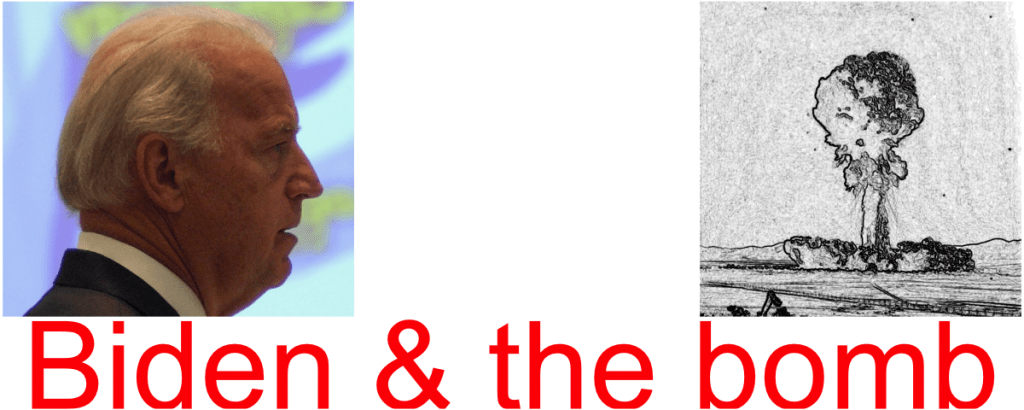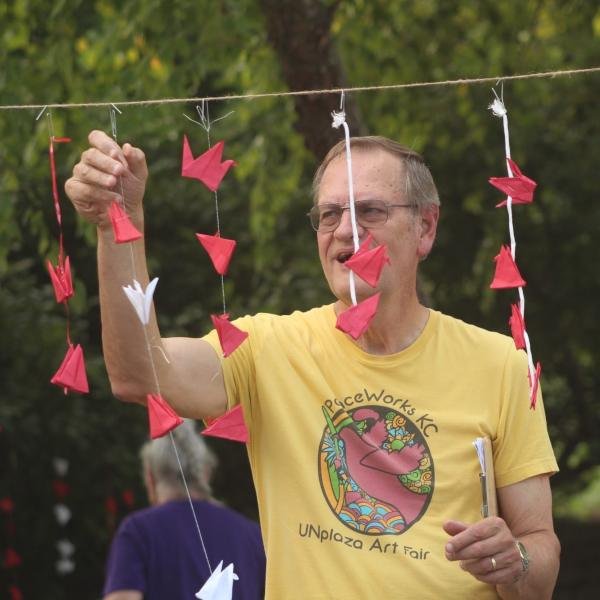by Spencer Graves
As Vice President, Joe Biden displayed some understanding of the threat that nuclear weapons pose to the future of humanity.1 However, the mainstream media has for decades suppressed an honest discussion of these issues.2 They will likely accuse Biden of threatening national security if he proposes any sensible policies in this area, unless a major groundswell of political activism forces an open discussion.
Remember Stuxnet, the computer virus that destroyed part of Iran’s uranium enrichment equipment in 2010? Former US Secretary of Defense William Perry said that a crudely similar virus could spook any of the world’s nuclear weapon states into believing they are being attacked. That could turn a false alarm into nuclear Armageddon.3 If that happens in India or Pakistan, the likely result will be a nuclear autumn during which a quarter of humanity will starve to death if they do not die of something else sooner.4 If it happens in the US, Russia, China, the UK or France, the death toll will likely be closer to 98 percent of humanity.5
The Cities Appeal by the International Campaign to Abolish Nuclear Weapons (ICAN)6 and the January 22 entry into force of the Treaty on the Prohibition of Nuclear Weapons (TPNW) can inspire US citizens to do the following:
-
Ask their Mayor to join Mayors for Peace if they aren’t already a member, like Mayor Eileen Weir of Independence7and former KCMO mayor Kay Barnes.8
-
Ask their city council to adopt a resolution urging their national government to become a party to the TPNW.
-
Ask their representatives in the US Congress to support the TPNW and lesser measures that reduce the risk of nuclear Armageddon.
Lesser measures include the following:9
-
Strengthen rather than cancel treaties limiting development, testing, deployment and proliferation of nuclear weapons.
-
No first use of a nuclear weapon.
-
No launch on warning: The risks of a false alarm vastly exceed the likelihood of a nuclear attack from any source.
-
No sole authority of any individual such as the president to authorize use of a nuclear weapon: Require congressional approval unless a nuclear attack made consultations impossible.
-
Store nuclear weapons separate from delivery vehicles.
-
Cancel the current nuclear “modernization” efforts.
Will you help reduce the risks of nuclear Armageddon before it’s too late?
We can do this. Sí, se puede.
Please refer comments and questions to spencer.graves@effectivedefense.org.
Spencer Graves, PhD, Founder, EffectiveDefense.org and Secretary, PeaceWorks Kansas City.
Biden image copyright 2007 Creative Commons Attribution 2.0 Generic license per:
https://commons.wikimedia.org/wiki/File:The_SEIU_family_listens_to_Sen._Joe_Biden_(cropped2).jpg
Mushroom cloud from US National Nuclear Security Administration and in the public domain.
https://commons.wikimedia.org/wiki/File:Plumbbob_Fizeau_003.jpg
text copyright 2020 CC BY-SA Spencer Graves
1. Vice President Joe Biden gave a speech in January 2017, just before Trump assumed office. Biden said, “Given our nonnuclear capabilities and the nature of today’s threats—it’s hard to envision a plausible scenario in which the first use of nuclear weapons by the United States would be necessary. Or make sense. President Obama and I are confident we can deter—and defend ourselves and our Allies against—nonnuclear threats through other means.”’ Cited from Perry and Collina (2020) The Button (BenBella Books, p. 98).
2. Wikiversity, “Confirmation bias and conflict“, accessed 2020-11-17.
4. Owen B. Toon; Alan Robock; Michael Mills; Lili Xia (May 2017), “Asia Treads the Nuclear Path, Unaware That Self-Assured Destruction Would Result from Nuclear War“, The Journal of Asian Studies, 76 (02): 437–456 (http://climate.envsci.rutgers.edu/pdf/ToonAsianStudies.pdf). In particular, they cite Helfand (2013) for saying that two billion people worldwide would likely starve to death from a nuclear autumn following a nuclear war between India and Pakistan. The world population in 2013 was estimated at a little over 7.1 billion. Two billion is just a little over a quarter of humanity.
5. Ellbserg 2017 cited in Wikiversity, “Time to nuclear Armageddon” (https://en.wikiversity.org/wiki/Time_to_nuclear_Armageddon).
6. ICAN Cities Appeal (https://cities.icanw.org).
7. “Mayors for Peace Gratefully Welcomes the Following New Members”, 2015-06-01 (http://www.mayorsforpeace.org/data/pdf/03_newmembers/2015/newmembers1506_en.pdf).


